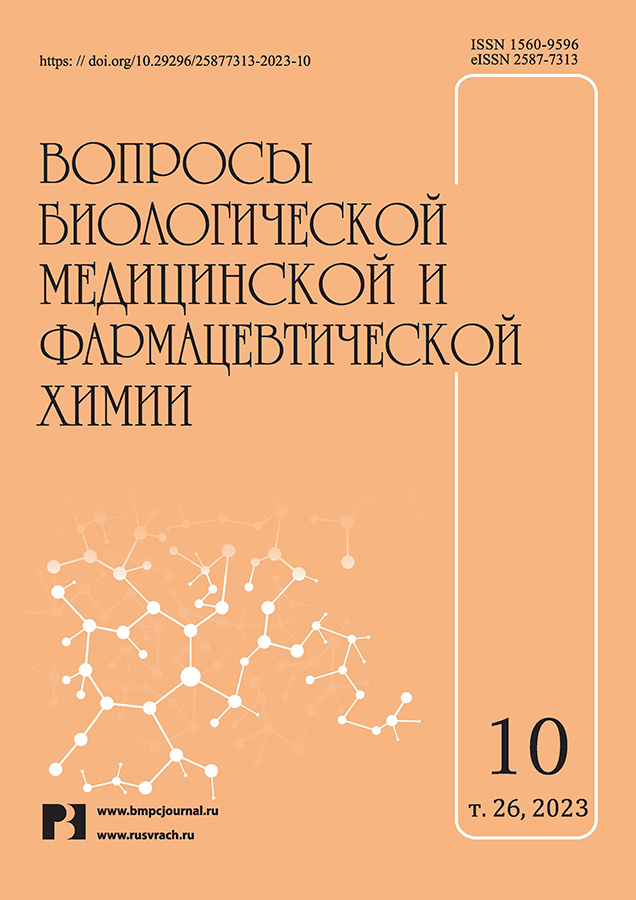Исследование биологической активности смешаннолигандных комплексов в отношении условно-патогенных штаммов
- Авторы: Плотникова Ю.А.1, Барышева Е.С.1, Баранова О.В.1, Давыдова О.К.1
-
Учреждения:
- ФГБОУ ВО «Оренбургский государственный университет»
- Выпуск: Том 26, № 10 (2023)
- Страницы: 32-37
- Раздел: Биологическая химия
- URL: https://journals.eco-vector.com/1560-9596/article/view/621438
- DOI: https://doi.org/10.29296/25877313-2023-10-05
- ID: 621438
Цитировать
Полный текст
Аннотация
Введение. Флавоноиды представляют собой самую большую группу природных молекул с антибактериальным действием, которое можно объяснить агрегацией бактериальных клеток и повреждением бактериальной мембраны. Модификация флавоноидами противомикробных препаратов может стать перспективной методикой в борьбе с антибиотикорезистентностью, поскольку присутствие в составе сложных структурных комплексов поможет скрыть или уменьшить распознавание бактериями антибактериальных веществ.
Цель работы – дать оценку изменению морфометрических показателей бактериальных клеток P. aeruginosa при комплексном воздействии антибактериальных препаратов и флавоноидов лекарственного растительного сырья.
Материал и методы. Объектом исследования явились штаммы Р. aeruginosa, выращенные на мясо-пептонном агаре, на которые воздействовали комплексами флавоноидов, выделенных из Dianthus и Folia eucalypti, с антибактериальными препаратами фосфомицин и цефтазидим. Визуализация морфометрических изменений и физическая характеристика объекта исследования осуществлялась с помощью атомно-силовой микроскопии (АСМ).
Результаты. Анализ полученных экспериментальных данных свидетельствует о том, что комбинации флавоноидов с цефтазидимом достоверно значимо уменьшали длину бактериальной клетки на 5,5% (р≤0,05) для Dianthus и на 13,02% (р≤0,001) для Folia eucalypti. Для комбинации данных фенольных извлечений Dianthus и Folia eucalypti с фосфомицином были характерны достоверно значимые увеличения длины на 28,86% (р≤0,001), уменьшения ширины на 11,03% (p≤0,01) и высоты на 55,91% (p≤0,001) в случае с Dianthus, уменьшения длины на 5,5% (р≤0,05) и высоты 55,38% (p≤0,001) для Folia eucalypti. Таким образом, достоверно значимые изменения морфометрии бактериальной клетки наблюдались в отношении всех образцов в сравнении с контролем.
Выводы. Полученные данные подтверждают изменения клеточной мембраны клеток, вызванные действием ингибирующих компонентов. Связывание антибактериальных комплексов с группами фосфолипидов изменяет распределение заряда по мембране, нарушаются внутренние мембранные процессы, ингибируется работа пеницилин-связывающих белков, вызывающая нарушение синтеза пептидогликана, и в конечном итоге влечет изменение морфологии клеток.
Полный текст
Об авторах
Ю. А. Плотникова
ФГБОУ ВО «Оренбургский государственный университет»
Автор, ответственный за переписку.
Email: shik8mail@mail.ru
зав. лабораторией, кафедра биохимии и микробиологии
Россия, г. ОренбургЕ. С. Барышева
ФГБОУ ВО «Оренбургский государственный университет»
Email: baryshevae@mail.ru
д.м.н., доцент, зав. кафедрой биохимии и микробиологии
Россия, г. ОренбургО. В. Баранова
ФГБОУ ВО «Оренбургский государственный университет»
Email: baranovaov@yandex.ru
к.б.н., доцент кафедры медико-биологической техники
Россия, г. ОренбургО. К. Давыдова
ФГБОУ ВО «Оренбургский государственный университет»
Email: okdavydova@yahoo.com
к.б.н., доцент кафедры биохимии и микробиологии
Россия, г. ОренбургСписок литературы
- Tarahovsky Yu.S., Kim Yu.A., Yagolnik E.A., Muzafarov E.N. Flavonoid–membrane interactions: Involvement of flavonoid–metal complexes in raft signaling. Biochimica et Biophysica Acta (BBA) – Biomembranes. 2014; 1838(5): 1235–1246. doi: 10.1016/j.bbamem.2014.01.021.
- Wu Ting, He Mengying, Zang Xixi, Zhou Ying, Qiu Tianfu, Pan Siyi, Xu Xiaoyun. A structure–activity relationship study of flavonoids as inhibitors of E. coli by membrane interaction effect. Biochimica et Biophysica Acta (BBA) – Biomembranes. 2013; 1828(11): 2751–2756.
- Холина Е.Г., Боздаганян М.Е., Страховская М.Г., Коваленко И.Б. Взаимодействие катионных антисептиков с кардиолипинсодержащей модельной бактериальной мембраной. Медицина экстремальных ситуаций. 2021; 3. URL: https://cyberleninka.ru/article/n/vzaimodeystvie-kationnyh-antiseptikov-s-kardiolipinsoderzhaschey-modelnoy-bakterialnoy-membranoy (дата обращения: 27.06.2023) (Holina E.G., Bozdaganjan M.E., Strahovskaja M.G., Kovalenko I.B. Vzaimodejstvie kationnyh antiseptikov s kardiolipinsoderzhashhej model'noj bakterial'noj membranoj. Medicina jekstrem-al'nyh situacij. 2021; 3. URL: https://cyberleninka.ru/article/n/vzaimodeystvie-kation-nyh-antiseptikov-s-kardiolipinsoderzhaschey-modelnoy-bakterialnoy-membranoy (data obrashhenija: 27.06.2023)).
- Zasowski E.J., Rybak J.M., Rybak M.J. The β-Lactams Strike Back: Ceftazidime-Avibactam. Pharmacotherapy. 2015 Aug; 35(8): 755–770. doi: 10.1002/phar.1622.
- Borisova M., Gisin J., Mayer C. Blocking peptidoglycan recycling in Pseudomonas aeruginosa attenuates intrinsic resistance to fosfomycin. Microb Drug Resist. 2014; 20: 231–237. doi: 10.1089/mdr.2014.0036.
- Pietta P.G. Flavonoids as antioxidants. Journal of Natural Products. 2000; 63(7): 1035–1042
Дополнительные файлы







